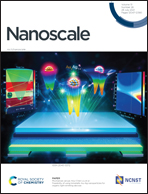Feasibility of using bimetallic Au–Ag nanoparticles for organic light-emitting devices†
Abstract
Matching the resonant wavelength of plasmonic nanoparticles (NPs) and the emission band of organic materials is critical for achieving optimal plasmon-enhanced luminescence in organic light-emitting devices (OLEDs). However, the spectral matching is often unsatisfactory because the interior architecture of OLEDs limits the dimensions of the NPs to support the desired wavelength adjustment. In this article, we proposed a design strategy via AuxAg1−x alloy NPs to enable resonance tuning while preserving the size of the NP to suit the OLED design requirements. The bimetallic NPs, especially for x < 0.6, not only add one more degree of freedom to vary the plasmon wavelength but also provide the benefits of higher scattering and more intense and outspread electric fields over a broader spectrum compared to Au monometallic NPs. These features allow smaller NPs, which are more compatible with OLED interiors, to scatter electric fields more efficiently and increase the density of molecules interacting with the NP plasmons. In the presence of a nearby dipole emitter, the bimetallic NPs can simultaneously increase radiative enhancement and suppress non-radiative losses, which are advantageous for increasing the quantum yield and luminescence efficiency of the emitter. These improvements are associated with lower intraband and interband activities resulting from the higher molar fraction of Ag in the alloy NPs. We provided composition mappings to achieve enhanced luminescence for specified wavelengths at fixed NP sizes. Finally, we theoretically demonstrated that the bimetallic NPs could improve the light-extraction efficiency of OLEDs better than Au monometallic NPs. This work provides essential guidance to enable versatile plasmon-enhanced applications with predefined nanostructural geometries and wavelengths to match the device requirements.



 Please wait while we load your content...
Please wait while we load your content...